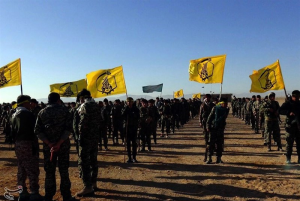The Iranian regime has long used Islamist groups as proxies to advance its objectives in the Middle East. Its notorious sponsorship of the Lebanese Hezbollah and the Palestinian Hamas since the 1980s, for instance, is well documented. What is less known, however, is Tehran’s more recent spiraling proxy warfare with the establishment of a transnational network of Shia militant groups, deployed to confront its adversaries across a variety of battlefields in the wider region. The Fatemiyoun Army is one of these newer proxies, composed entirely of Afghan Shia fighters, deployed to defend Iranian interests in Syria, Iraq, and Yemen. This new, transnational aspect of Iran’s traditional proxy warfare can have broad regional implications, threatening U.S. interests, as well as its allies, across the Middle East and South Asia.
I began monitoring the Fatemiyoun in early 2015 as part of my portfolio in the Afghan National Security Council, although the group had been created two years earlier amid the violent upheavals that swept across the Middle East in the aftermath of the “Arab Spring.” Reacting to the regional turmoil, Iran’s Revolutionary Guard’s Quds Force, responsible for unconventional warfare and military intelligence, established four new Shia militant groups – Fatemiyoun, Zainabiyoun, Aliyoun, and Haidariyoun – named after Prophet Mohammad’s family members, and composed of fighters from Afghanistan, Pakistan, Iraq, and Syria, respectively. They were all to fight on various battlefields in the Middle East, but the Fatemiyoun grew to be the largest and most formidable, backing Tehran’s ally Bashar al-Assad in the Syrian war and later the Houthis in Yemen.
The origins of the Fatemiyoun traces to the now defunct “Mohammad Corp” and the “Abuzar Division,” both Afghan Shia militant groups commissioned by Iran to fight in the Iran-Iraq war in the 1980s and later against the Taliban in the ’90s. A handful of veterans from these groups, led by Ali Reza Tavassoli, formed the core of the Fatemiyoun in 2013 from which the Quds Force amassed an army of more than 20,000 militants over the next three years. Fighters were predominantly recruited from among Shia Afghan refugees in Iran, enticed with the mission of “safeguarding the shrines of the Prophet’s granddaughters in Damascus.” Beside religious inducement, the Quds Force also offered a host of material incentives, including legal residency, free schooling for children, health insurance, monthly payments of up to $1,500, and social status upon return. Some were even coerced into joining with threats of arrest and deportation if they refused. Most of the approximately 3 million Afghan refugees in Iran live a precarious existence, pressed by extreme economic hardship on the one hand, and harsh xenophobic discrimination on the other, making such incentives extremely appealing.
As the fighting intensified in Syria, the Quds Force began reaching out to the Shia Hazara population inside Afghanistan too, establishing recruiting networks in multiple provinces, including the capital Kabul. Recruits were transported under the guise of pilgrimage trips to holy shrines in Syria and Iraq, using travel agencies with close connections to the Iranian Embassy in Kabul. Once in Iran, the recruits would undergo a fortnight of training in tactical guerrilla moves and basic weapons handling, run in complete secrecy by the Quds Force. The men were then shipped to Syria, raced to the shrine of Zainab bint Ali for a quick visit, and then immediately deployed to the battlefields. Viewed as “cannon fodder,” Fatemiyoun fighters were sent to some of the toughest fronts, including Latakia, Hama, Idlib, Aleppo, Damascus, and Daraa, resulting in outsized casualty rates. Estimates suggest that between 2013 and 2019, over 50,000 Fatemiyoun militants fought in the Middle East, suffering a staggering casualty rate of over 5,000 deaths and 4,000 wounded. The dead included the group’s original leader, Ali Reza Tavassoli, and several of his successors.
With the dwindling of the war in Syria, a number of these fighters were deployed to Yemen to support the Iranian Houthi allies, some returned to Iran, and many relocated to Afghanistan. The Quds Force, nevertheless, keeps an active division of about 8,000 Fatemiyoun fighters in Syria, and maintains contact with those in Afghanistan. In the face of consistent attacks by Sunni militants, as well as the increasing possibility of the Taliban’s return to power, Afghan Shias feel extremely vulnerable, warranting the emergence of the Fatemiyoun as a Shia defense force.
Recent events, though small in scope, confirm this prediction: Last month, for instance, militiamen belonging to a local Hazara commander, Ali Pur, who is allegedly connected to the Fatemiyoun, shot down an Afghan army helicopter, resulting in the death of nine security personnel and bloody retaliatory action by the army. Two weeks later, another group of Hazara Shias, purported to be the first active face of the Fatemiyoun in Afghanistan, announced the establishment of a military division to “defend the Shias against widespread attack and systematic discrimination” in central Afghanistan. This is but the tip of a large iceberg that could surface as ethnic and sectarian tensions among Afghans are on the rise in the face of the impending U.S. troop withdrawal.
The problem does not end with Afghanistan, however. The Fatemiyoun is but one of the many actors within Iran’s new transnational network of Shia groups that operate on an ideology of “pan-Shia militancy” in a region riddled with conflict. As the self-declared custodian of Shia Islam, the Iranian regime faces numerous adversaries, including the Sunni Gulf states, Israel, and, of course ,the United States. In the face of this presumed “existential threat,” Iran seeks to utilize any and all means to ensure its survival and advance its interests. Loyal proxy groups, like the Fatemiyoun Army, provide Tehran with a cost-effective means to confront its stronger foes, and wield substantial leverage over the region’s affairs. Most security agencies, including those of the Afghan government in which I served, have thus far downplayed the group’s significance. But my five-year close study of the group leads me to believe that the Fatemiyoun is poised to become a second Hezbollah within Tehran’s proxy arsenal.

































